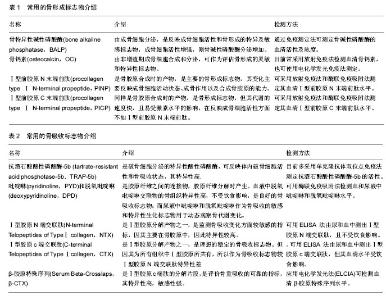Chinese Journal of Tissue Engineering Research ›› 2016, Vol. 20 ›› Issue (35): 5290-5295.doi: 10.3969/j.issn.2095-4344.2016.35.018
Previous Articles Next Articles
Measurement of bone metabolism markers and changes of bone mineral density in patients with bone and joint disease and fractures in perioperative period
Li Shi-hong, Liu Yang
- Clinical Laboratory Center, Third Affiliated Hospital, Jinzhou Medical University, Jinzhou 121000, Liaoning Province, China
-
Revised:2016-07-12Online:2016-08-26Published:2016-08-26 -
Contact:Liu Yang, M.D., Associate chief inspection technician, Clinical Laboratory Center, Third Affiliated Hospital, Jinzhou Medical University, Jinzhou 121000, Liaoning Province, China -
About author:Li Shi-hong, Inspection technician-in-charge, Clinical Laboratory Center, Third Affiliated Hospital, Jinzhou Medical University, Jinzhou 121000, Liaoning Province, China
CLC Number:
Cite this article
Li Shi-hong, Liu Yang. Measurement of bone metabolism markers and changes of bone mineral density in patients with bone and joint disease and fractures in perioperative period[J]. Chinese Journal of Tissue Engineering Research, 2016, 20(35): 5290-5295.
share this article
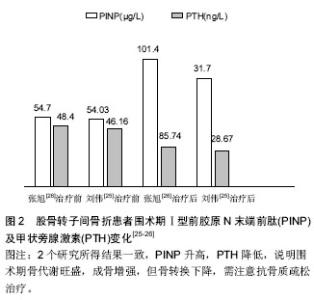
2.2 骨折手术患者围术期骨代谢标志物及骨密度的变化 骨折后局部骨量减少、骨转换增加,骨折患者围术期骨代谢的变化有其特点:①骨折后的疼痛及骨折围术期制动造成患者骨量的进一步丢失,使骨分解的生化标志物增加;②骨折同时启动骨愈合机制,因此在成骨活跃期血中骨形成标志物水平即会产生变化;③骨折围术期坏死骨的清除又使骨吸收性标志物水平变化。 刘伟等[25]的研究纳入了40 例女性股骨转子间骨折患者,年龄61-93岁,均为跌倒所致骨折,排除了类风湿性炎节炎、强直性脊柱炎、骨肿瘤或或甲旁亢等影响骨代谢的疾病。在患者入院后次日及术后3个月抽血,测定Ⅰ型前胶原N末端前肽、Ⅰ型胶原C端交联肽、骨钙素、甲状旁腺激素、25-羟基维生素D等骨代谢指标,同时行髋关节骨密度、髋关节骨强度测定。结果发现,术后3个月时,骨形成标志物Ⅰ型前胶原N末端前肽较术前明显增高,甲状旁腺激素较术前降低,差异有显著性意义(P < 0.05);而股骨颈、大转子及转子间的骨密度及骨强度与术前相比轻度下降,但差异无显著性意义(P > 0.05)。结果说明股骨转子间骨折围术期骨代谢旺盛,成骨加强,而甲状旁腺激素水平提示至术后3个月骨转换已经下降,但此时骨强度并无明显改善,因此需注意防护,加强抗骨质疏松治疗,避免发生再次骨折。张旭等[26]的临床回顾性研究与刘伟等相似,观察了47例女性股骨转子间骨折患者术前及术后3个月的血骨代谢指标变化,2个研究所得结果一致(图2),治疗前和治疗后3个月比较,骨密度变化不大,Ⅰ型前胶原N末端前肽增高,甲状旁腺激素降低(P < 0.05)。 石磊等[27]为了解骨科手术患者围手术期骨代谢变化特点,纳入了113例50岁以上的中老年骨科手术患者,其中49例是髋部骨折患者。此49例患者术后1周的骨吸收标志物Ⅰ型胶原交联C端肽为(0.66±0.40) μg/L,较术前(0.36±0.25) μg/L明显上升(P < 0.05),提示骨折患者术后骨吸收加快;骨形成标志物骨钙素术后1周与术前比差异不显著[(13.94±7.33),(14.43±7.84) μg/L,P > 0.05],作者认为骨钙素未降低是骨折引起成骨活跃抵消了骨钙素降低的结果。"
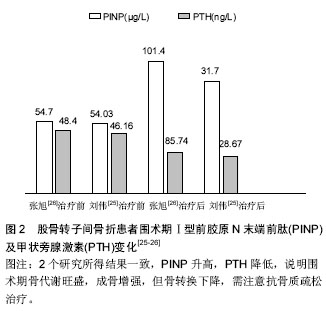
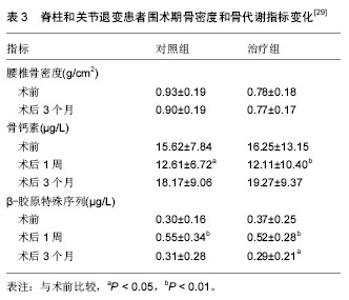
2.3 骨关节病手术患者围术期骨代谢标志物及骨密度的变化 脊柱和关节退变需手术治疗患者中骨质疏松、骨量减少的发生率较高,且体内维生素D缺乏情况较普遍,围手术期更容易出现骨量丢失、骨代谢紊乱。因此在骨关节退行性病手术患者围术期监测骨代谢标志物,有助于骨质疏松的防治及骨折风险预测。 王旭等[28]收集139例脊柱退行性疾病手术治疗患者,分析骨代谢指标与骨密度之间的关系,并进一步探讨合并2型糖尿病对骨代谢和骨密度的影响。结果139例患者中骨量正常者仅为16.0%,87%体内维生素D缺乏(25-羟基维生素D<50 nmol/L),说明此类患者普遍存在骨质疏松、骨量减少和维生素D缺乏的状况;多因素线性回归分析结果提示年龄、Ⅰ型前胶原N末端前肽是决定脊柱退行性疾病需手术患者骨密度变化的主要影响因素,这提示伴Ⅰ型前胶原N末端前肽升高的老龄患者,骨密度降低及骨质疏松的发病风险更大;糖尿病组患者的血Ⅰ型前胶原N末端前肽、β-胶原特殊序列及骨钙素水平均低于肥糖尿病组,说明合并2型糖尿病的患者处于一种低骨转换状态。 石磊等[27]报告的113例50岁以上的中老年骨科手术患者中包括脊柱和关节退变者64例,应用电化学发光免疫方法测定术前及术后1周血骨钙素及Ⅰ型胶原交联C端肽水平。此64例患者术后1周的骨吸收标志物Ⅰ型胶原交联C端肽为(0.52±0.30) μg/L,较术前(0.39±0.32) μg/L明显上升(P < 0.05),提示骨折患者术后骨吸收加快;骨形成标志物骨钙素术后1周低于术前[(12.37±8.66),(16.70±11.45) μg/L,P < 0.05],提示经手术干预后,骨形成过程受到抑制。在以上研究的基础上,石磊等[29]进一步观察了抗骨质疏松治疗对骨科手术患者围术期骨代谢的影响,他们纳入了90例老年骨科手术患者,其中脊柱和关节退变患者55例,骨折患者35例。90例患者被随机分为2组,对照组术后常规口服碳酸钙片和活性维生素D,治疗组在对照组基础上应用鲑鱼降钙素肌内注射或喷鼻,分别于术前、术后1周、术后3个月测定血骨钙素及β-胶原特殊序列水平,于术前、术后3个月采用DEXA双能X线骨密度仪测定患者腰椎及髋部骨密度。结果发现老年患者接受骨科手术前后骨代谢发生改变,手术后1周骨吸收过程活跃,骨形成过程受抑制;术后应用抗骨吸收类药物鲑鱼降钙素3个月抗骨质疏松治疗能有效抑制骨吸收,但对促进骨形成无明显影响(表3)。"
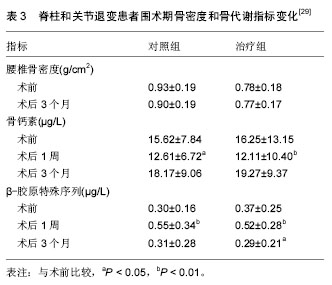
| [1] Lee J,Vasikaran S.Current recommendations for laboratory testing and use of bone turnover markers in management of osteoporosis.Ann Lab Med.2012;32(2): 105-112.
[2] 欧萌萌,黄建荣.绝经后妇女骨质疏松症患者血清β-Crosslaps、PINP和N-MID检测的评价[J].标记免疫分析与临床,2011,18(4): 238-240.
[3] Michelsen J, Wallaschofski H, Friedrich N, et al.Reference intervals for serum concentrations of three bone turnover markers for men and women.Bone. 2013; 57(2):399-404.
[4] Mohamed Y, Haifa H, Datel O, et al.The role of biochemical markers of bone turnover in the diagnosis of osteoporosis and predicting fracture risk.Tunis Med. 2014; 92(5):304-310.
[5] Chopin F,Biver E,Funck-Brentano T,et al.Prognostic interest of bone turnover markers in the management of postmenopausal osteoporosis.Joint Bone Spine. 2012;79(1): 26-31.
[6] 张春萍,陆惠华,江尧湖,等.老年I型胶原特异性序列及骨密度与骨质疏松相关性分析[J].中国老年学杂志,2002, 22(4): 258-259.
[7] Szulc P, Delmas PD.Biochemical markers of bone turnover: potential use in the investigation and management of postmenopausal osteoporosis. Osteoporos Int. 2008; 19(12):1683-1704.
[8] Vasikaran S, Eastell R, Bruyère O, et al. Markers of bone turnover for the prediction of fracture risk and monitoring of osteoporosis treatment: a need for international reference standards. Osteoporos Int. 2011;22:391-420.
[9] Bauer D, Krege J, Lane N, et al.National Bone Health Alliance Bone Turnover Marker Project: current practices and the need for US harmonization, standardization, and common reference ranges. Osteoporos Int. 2012; 23(10):2425-2433.
[10] Vasikaran S, Cooper C, Eastell R, et al.International Osteoporosis Foundation and International Federation of Clinical Chemistry and Laboratory Medicine position on bone marker standards in osteoporosis.Clin Chem Lab Med. 2011; 49(8):1271-1274.
[11] 赵和平.P1N P、β-Crosslaps与绝经老年女性骨质疏松相关性研究[J].陕西医学杂志,2014,16(7): 865-866.
[12] Kim SW, Park DJ, Park KS, et al.Early changes in biochemical markers of bone turnover predict bone mineral density response to antiresorptive therapy in Korean postmenopausal women with osteoporosis. Endocr J. 2005; 52(6):667-674.
[13] El Maataoui A, Biaz A, El Boukhrissi F, et al.Association between sex hormones, bone remodeling markers and bone mineral density in postmenopausal women of Moroccan origin (cross-sectional study)].Pan Afr Med J. 2015; 22:106.
[14] Dai Z, Wang R, Ang LW, et al.Bone turnover biomarkers and risk of osteoporotic hip fracture in an Asian population.Bone. 2016; 83:171-177.
[15] Delmas PD.Biochemical markers of bone turnover.J Bone Miner Res.1993;8(2):549-555.
[16] 施鸣,范璐,陈新.骨代谢标志物与骨质疏松的相关性研究[J].标记免疫分析与临床,2012,19(6):351-353.
[17] Bauer DC,Garnero P,Harrison SL,et al.Biochemical markers of bone turnover, hip bone loss, and fracture in older men: the MrOS study.J Bone Miner Res.2009; 24(12):2032-2038.
[18] Delmas PD, Licata AA, Reginster JY, et al.Fracture risk reduction during treatment with teriparatide is independent of pretreatment bone turnover.Bone. 2006; 39(2):237-243.
[19] 范永前,张旭,林伟龙,等.股骨粗隆间骨折骨代谢生化指标测定[J].中国骨与关节损伤杂志,2013,28(12): 1140-1142.
[20] 童明宏,肖国平,丁慧.骨质疏松症与骨转换标志物的相关性研究[J].检验医学,2013,28(2): 111-113.
[21] Meier C,Nguyen TV,Center JR,et al.Bone resorption and osteoporotic fractures in elderly men: the dubbo osteoporosis epidemiology study.J Bone Miner Res.2005;20(4):579-587.
[22] Civitelli R,Armamento-Villareal R,Napoli N.Bone turnover markers: understanding their value in clinical trials and clinical practice.Osteoporos Int.2009;20(6): 843-851.
[23] Cheung AM, Majumdar S, Brixen K, et al.Effects of odanacatib on the radius and tibia of postmenopausal women: improvements in bone geometry, microarchitecture, and estimated bone strength.J Bone Miner Res. 2014; 29(8):1786-1794.
[24] Gleason CE, Dowling NM, Wharton W, et al.Effects of Hormone Therapy on Cognition and Mood in Recently Postmenopausal Women: Findings from the Randomized, Controlled KEEPS-Cognitive and Affective Study.PLoS Med. 2015; 12(6):e1001833; discussion e1001833.
[25] 刘伟,张旭,范永前,等.股骨粗隆间骨折患者手术前后骨代谢、骨密度和骨强度变化研究[J].实用骨科杂志,2014, 20(5):415-419.
[26] 张旭,林伟龙,李慧林,等.老年股骨粗隆间骨折患者围手术期的血骨代谢指标[J].复旦学报(医学版),2014,41(5): 706-707,710.
[27] 石磊,薛庆云,张启维,等.中老年人骨科围手术期有关骨代谢指标变化的研究[J].中华骨质疏松和骨矿盐疾病杂志, 2009,2(2):99-103.
[28] 王旭,张会英,娄路馨,等.脊柱退行性疾病需手术治疗患者骨代谢指标与骨密度关系的研究[J].中华检验医学杂志,2016,39(4):267-271.
[29] 石磊,纪泉,张啟维,等.鲑鱼降钙素对老年骨科手术后患者骨代谢的影响[J].中华骨质疏松和骨矿盐疾病杂志,2014, 7(3):227-232. |
| [1] | Wang Ling, Zhao Hong-xia, Hua Qiang. Percutaneous vertebroplasty, percutaneous kyphoplasty and expansive pedicle screw fixation for repairing primary osteoporotic thoracolumbar fractures [J]. Chinese Journal of Tissue Engineering Research, 2017, 21(3): 350-355. |
| [2] | Song Quan-sheng, Tang Fu-bo, Wang Xiao-hu, Zhang Jia-li, Li Zhi-fei, Rao Yuan-sen, Wu Liang, Tai Zhi-hong, Qin Hai-biao, Xu Jian-wen. Relationship between the lumbar quantitative computed tomography values and contrast agent dispersion in osteoporotic thoracolumbar fractures [J]. Chinese Journal of Tissue Engineering Research, 2017, 21(19): 3051-3056. |
| [3] | Ren Rong, Li Ling-wei, Guo Qi-fa. Feasibility of implantation of a cemented femoral stem in the treatment of osteoporotic femoral neck fracture in elderly patients: study protocol of a randomized controlled trial [J]. Chinese Journal of Tissue Engineering Research, 2016, 20(48): 7261-7266. |
| [4] | Xu Can, Li Ming-qing, Wang Cheng-gong, Li Kang-hua, Liu Hua. Research progress of bone microarchitecture and microdamage detection [J]. Chinese Journal of Tissue Engineering Research, 2016, 20(44): 6673-6681. |
| [5] | Zhang Yan, Yang Qiu-ping, Zhao Yan, Zhao Yu-mei, Tan Hong, Du Si-cheng. Establishing a rat model of type 2 diabetes: its bone metabolism level [J]. Chinese Journal of Tissue Engineering Research, 2016, 20(40): 6041-6047. |
| [6] | Chen Jin-dong, Xu Xin, Sun Dong-hong, Min Cui-xia, Chen Yang, Liu Xiu-mei . Difference in periprosthetic acetabular bone mineral density between osteonecrosis and osteoarthritis patients after primary total hip arthroplasty [J]. Chinese Journal of Tissue Engineering Research, 2016, 20(39): 5788-5793. |
| [7] | Wei Jun-qiang, Liu Li-rui, Wang Xin-yu, Yan Shi, Jin Yu, Feng Zhen. Proximal femoral nail antirotation fixation for osteoporotic intertrochanteric fracture in the elderly: characteristics of deep venous thrombosis of lower extremity [J]. Chinese Journal of Tissue Engineering Research, 2016, 20(35): 5224-5230. |
| [8] | Zhang Hui, Gao Zhong-yu, Xu Cai-yuan, Zhang Tong-xing, Zhang Tao. Vertebroplasty for osteoporotic vertebral compression fractures: missed diagnosis, severe vertebral compression, bone cement leakage and recurrent fractures in 225 cases [J]. Chinese Journal of Tissue Engineering Research, 2016, 20(35): 5256-5262. |
| [9] | Zhang Yi-long, Ren Lei, Sun Zhi-jie, Wang Ya-hui, Sun He. New vertebral compression fractures after vertebroplasty: association with osteoporosis and spinal sagittal imbalances [J]. Chinese Journal of Tissue Engineering Research, 2016, 20(35): 5263-5269. |
| [10] | Wu Jian-jun. Biocompatibility of Sextant minimally invasive pedicle screw fixation for osteoporotic vertebral fractures in the elderly [J]. Chinese Journal of Tissue Engineering Research, 2016, 20(31): 4603-1609. |
| [11] | Ning Xu, Zhuang Yong, Liu Miao, Zhang Hao, Huang Ming-zhi. Biomechanical properties of lower anterior vertebral pedicle screw system and its effects on osteoporotic vertebral stability [J]. Chinese Journal of Tissue Engineering Research, 2016, 20(31): 4665-4670. |
| [12] | Liu Yang, Liu Dan, Xiao Yun-xiang, Chen Hai-dan, Zhao Hong-wei. Biomechanical properties of a novel pourable cement pedicle screw and its application to osteoporotic lumbar degeneration [J]. Chinese Journal of Tissue Engineering Research, 2016, 20(31): 4671-4676. |
| [13] | Yu Hai-ming, Li Yi-zhong, Yao Xue-dong, Lin Jin-kuang, Pan Yuan-cheng, Zhuang Hua-feng,Wang Pei-wen. Percutaneous vertebroplasty or percutaneous kyphoplasty for Kummell’s disease with vertebral posterior wall collapse: how to treat individually? [J]. Chinese Journal of Tissue Engineering Research, 2016, 20(26): 3856-3862. |
| [14] | Ren Zhi-shuai, Cheng Zhao-jun, Sun He-jun, Sun Zhen-hui, Cui Zi-jian, Zhang Li-long, Lin Yong-zhi, Zhang Ren-zan, Peng Bing, Zhang Xue-li. Osteoporosis-related factors in patients with knee osteoarthritis before total knee arthroplasty [J]. Chinese Journal of Tissue Engineering Research, 2016, 20(22): 3212-3218. |
| [15] | Zhang Yi-long, Sun Zhi-jie, Wang Ya-hui, Ren Lei, Sun He . Osteoporotic vertebral compression fractures: correlation between number of fractured vertebrae and C7 plumb line/sacro-femoral distance ratio [J]. Chinese Journal of Tissue Engineering Research, 2016, 20(22): 3315-3321. |
| Viewed | ||||||
|
Full text |
|
|||||
|
Abstract |
|
|||||
